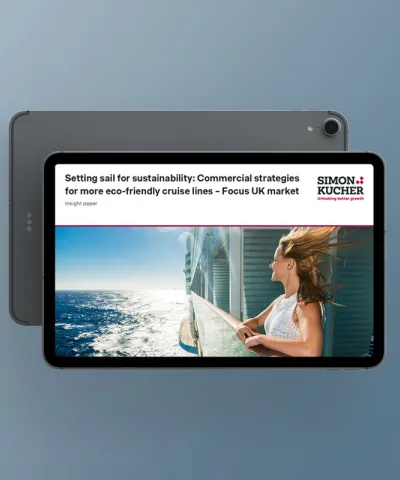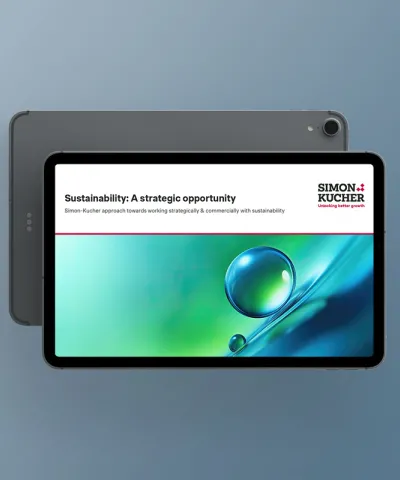Adopting sustainability measures is a challenge but important opportunity for financial service companies. Industry experts Morten Kaae Sorensen and Caroline Kastbjerg outline three strategies companies can adopt to meet the growing demand for sustainable financial services.
Environmental, social, and governance (ESG) measures, once seen primarily as a means to minimize risk, are now considered real business opportunities by many companies.
Our Global Sustainability Study proved that a significant number of consumers care about sustainability and are willing to act on it via their purchasing behavior. This share will only increase as generations shift and as sustainable disruptors emerge. So how can the financial sector best meet the needs of the sustainable customer segment?
We see three key strategies that financial services industry players are adopting to meet the emerging demand for sustainable financial products and services.
1. Sustainable off-setting
A strategic response we’ve observed is when banks link their traditional core offering with a sustainable off-setting feature. This approach ensures that a brand becomes positively associated with sustainability.
Offering sustainable off-setting features has been used by several fintechs. The Swiss company neon, for example, plants a tree for every 100 Swiss francs spent, and the German company Tomorrow promises that every euro paid protects one square meter of rainforest from deforestation.
Another example is the Danish fintech bank Lunar and their collaboration with Project Blue. Through Project Blue, Lunar customers can support the establishment of Seabins that clean the oceans of plastic waste in the Nordics by adding a contribution – e.g., 1 Danish Krone per 1,000 Danish Krone spend on their Visa card. Customers are then able to track the impact of their donation via the Lunar app.
Offering off-setting options is a step in the ‘green direction’ to creating awareness and capturing part of the sustainable market. However, it will only satisfy the sustainable consumer for so long.
While we believe these initiatives will appeal to “green conscience” consumers, we believe that the opportunity to differentiate from competitors is limited using this strategy. This is because the link to the core business isn’t strong, and the initiatives can easily be imitated.
2. Sustainable core products
Another strategic response is to (re-)design core financial products. ESG investment products are gaining ground rapidly across Europe, and in some markets (like the Nordics) it’s become mainstream for banks to offer green lending products. For example, green car loans or energy loans where customers are awarded with a discount on their interest rate.
In Germany, Ethikbank offers green mortgage-backed construction financing to private customers. In this case, the more sustainability criteria your construction project fulfills, the lower the interest rate you get on your loan. A more extreme example is a small Danish retail bank that was the first financial institution to say no to financing new petrol and diesel cars in Denmark. Now it only offers car loans to new electric cars.
By offering green financial products the financial sector can support the green transition while meeting the growing demand for sustainable offerings. The challenge with this strategy is that green loans and investment products are becoming mainstream. This means that it’s becoming harder for companies to differentiate themselves using this strategy.
Another issue is how to price green financial products. With interest rates in some cases lower than 1 percent on green loans, banks are risking creating a self-induced race to the bottom. What happens when all cars are electric?
To ensure that this strategy is an ongoing means to differentiation and profitability, financial institutions need to continuously innovate their green offering to stay ahead. In general, when (re)designing products, sustainable as well as traditional, it’s crucial to have a deep understanding of your different customer segments and to identify their needs, preferences, and willingness to pay.
3. Sustainable advisors
The interest and attention on the topic of sustainability and ESG will only increase going forward. This implies both new challenges and opportunities for companies.
From August 2022, the MiFID II regulation will require investment advisors to start assessing customers’ sustainability preference as part of suitability assessments. We believe that while adapting to the new requirements will imply new challenges for many companies, it should also be viewed as a strategic opportunity.
Financial service companies will play a pivotal role in the global shift toward sustainability. By helping customers make more sustainable investments and consumption choices – from offering expert advisory services to supporting digital tools – financial service companies can become the sustainability advisors of tomorrow.
Some banks have already started this journey. In the Nordics, Nykredit bank has put all their advisors in the agricultural segments through a climate education. This education is also offered to farmers along with a climate tool that will give each farmer an up-to-date status of their farm’s climate impact and calculate the effect of different, possible climate actions.
In personal banking Novus bank helps customers track individual carbon footprint based on spend and provides advice and alternatives for more sustainable spend.
Although there exists a fine line between moralizing customers and providing sustainability advice and solutions, it’s an opportunity for banks and other financial service companies that, in our opinion, is too good to pass. This is the time to shine for the banks and financial institutions that manage to fulfill the needs of the sustainable consumer via a holistic product and service offering.
Reaction vs. action: The winners of tomorrow
The sustainability initiatives we’re currently seeing in the financial service industry is a first step down a long road ahead. The winners will be the companies that manage not only to react to but to act on the challenges and opportunities presented by sustainability. These are companies that manage to visualize and execute innovative sustainability initiatives that meet the future needs of their customers.
In our opinion, adapting to sustainability should not only be an imperative for long-term profitability and viability, but also an opportunity too valuable to pass.








